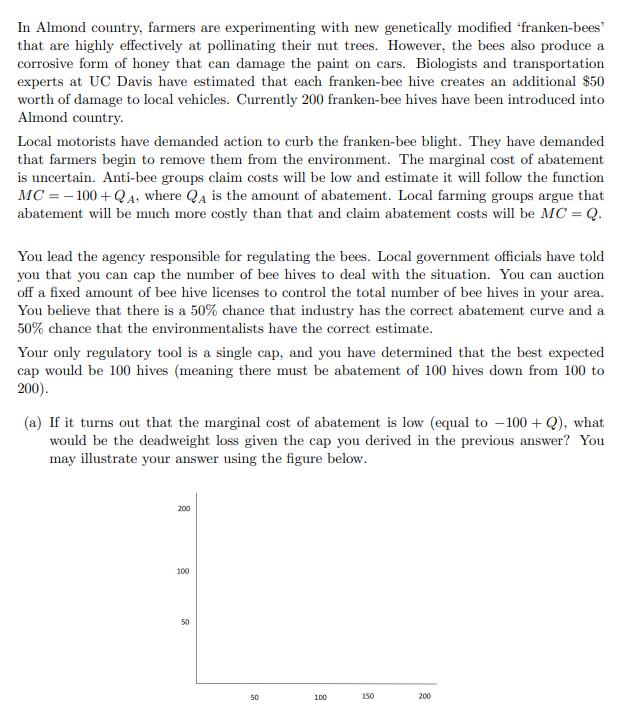Answered step by step
Verified Expert Solution
Question
1 Approved Answer
In Almond country, farmers are experimenting with new genetically modified franken-bees' that are highly effectively at pollinating their nut trees. However, the bees also


In Almond country, farmers are experimenting with new genetically modified franken-bees' that are highly effectively at pollinating their nut trees. However, the bees also produce a corrosive form of honey that can damage the paint on cars. Biologists and transportation experts at UC Davis have estimated that each franken-bee hive creates an additional $50 worth of damage to local vehicles. Currently 200 franken-bee hives have been introduced into Almond country. Local motorists have demanded action to curb the franken-bee blight. They have demanded that farmers begin to remove them from the environment. The marginal cost of abatement is uncertain. Anti-bee groups claim costs will be low and estimate it will follow the function MC = -100+QA, where QA is the amount of abatement. Local farming groups argue that abatement will be much more costly than that and claim abatement costs will be MC = Q. You lead the agency responsible for regulating the bees. Local government officials have told you that you can cap the number of bee hives to deal with the situation. You can auction off a fixed amount of bee hive licenses to control the total number of bee hives in your area. You believe that there is a 50% chance that industry has the correct abatement curve and a 50% chance that the environmentalists have the correct estimate. Your only regulatory tool is a single cap, and you have determined that the best expected cap would be 100 hives (meaning there must be abatement of 100 hives down from 100 to 200). (a) If it turns out that the marginal cost of abatement is low (equal to 100+Q), what would be the deadweight loss given the cap you derived in the previous answer? You may illustrate your answer using the figure below. 200 100 50 50 100 150 200 (b) Now assume that you can also introduce a floor price on bee-hives and that you will only sell a license if the price rises above $30 a hive. However you will never sell more than the cap of 100 hives. Now what would be the deadweight loss if the marginal cost of abatement again turns out to be low? You may illustrate your answer using the figure below. 200 100 50 50 100 150 200
Step by Step Solution
There are 3 Steps involved in it
Step: 1
a If the marginal cost of abatement is low MC 100Q then the abatement cost curve is as shown MC 100Q ...
Get Instant Access to Expert-Tailored Solutions
See step-by-step solutions with expert insights and AI powered tools for academic success
Step: 2

Step: 3

Ace Your Homework with AI
Get the answers you need in no time with our AI-driven, step-by-step assistance
Get Started


